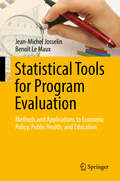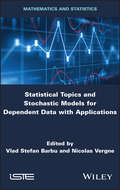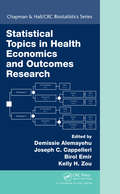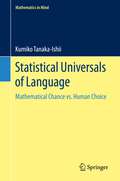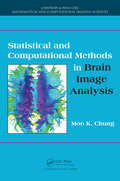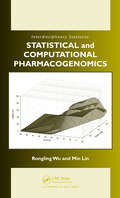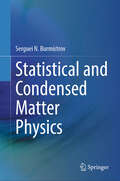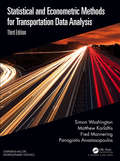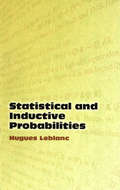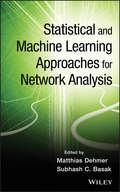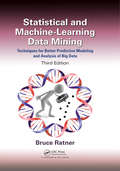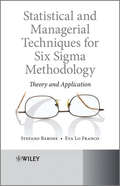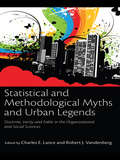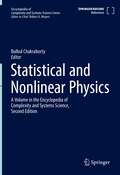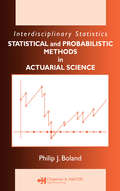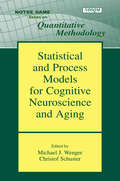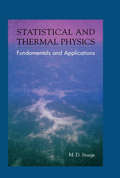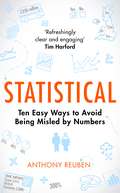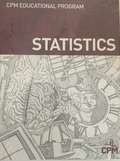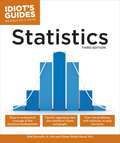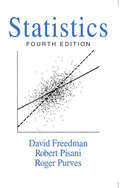- Table View
- List View
Statistical Tools for Program Evaluation: Methods and Applications to Economic Policy, Public Health, and Education
by Jean-Michel Josselin Benoît Le MauxThis book provides a self-contained presentation of the statistical tools required for evaluating public programs, as advocated by many governments, the World Bank, the European Union, and the Organization for Economic Cooperation and Development. After introducing the methodological framework of program evaluation, the first chapters are devoted to the collection, elementary description and multivariate analysis of data as well as the estimation of welfare changes. The book then successively presents the tools of ex-ante methods (financial analysis, budget planning, cost-benefit, cost-effectiveness and multi-criteria evaluation) and ex-post methods (benchmarking, experimental and quasi-experimental evaluation). The step-by-step approach and the systematic use of numerical illustrations equip readers to handle the statistics of program evaluation. It not only offers practitioners from public administrations, consultancy firms and nongovernmental organizations the basic tools and advanced techniques used in program assessment, it is also suitable for executive management training, upper undergraduate and graduate courses, as well as for self-study.
Statistical Topics and Stochastic Models for Dependent Data with Applications
by Vlad Stefan Barbu Nicolas VergneThis book is a collective volume authored by leading scientists in the field of stochastic modelling, associated statistical topics and corresponding applications. The main classes of stochastic processes for dependent data investigated throughout this book are Markov, semi-Markov, autoregressive and piecewise deterministic Markov models. The material is divided into three parts corresponding to: (i) Markov and semi-Markov processes, (ii) autoregressive processes and (iii) techniques based on divergence measures and entropies. A special attention is payed to applications in reliability, survival analysis and related fields.
Statistical Topics in Health Economics and Outcomes Research (Chapman & Hall/CRC Biostatistics Series)
by Joseph C. Cappelleri Demissie Alemayehu Birol Emir Kelly H. ZouWith ever-rising healthcare costs, evidence generation through Health Economics and Outcomes Research (HEOR) plays an increasingly important role in decision-making about the allocation of resources. Accordingly, it is now customary for health technology assessment and reimbursement agencies to request for HEOR evidence, in addition to data from clinical trials, to inform decisions about patient access to new treatment options. While there is a great deal of literature on HEOR, there is a need for a volume that presents a coherent and unified review of the major issues that arise in application, especially from a statistical perspective. Statistical Topics in Health Economics and Outcomes Research fulfils that need by presenting an overview of the key analytical issues and best practice. Special attention is paid to key assumptions and other salient features of statistical methods customarily used in the area, and appropriate and relatively comprehensive references are made to emerging trends. The content of the book is purposefully designed to be accessible to readers with basic quantitative backgrounds, while providing an in-depth coverage of relatively complex statistical issues. The book will make a very useful reference for researchers in the pharmaceutical industry, academia, and research institutions involved with HEOR studies. The targeted readers may include statisticians, data scientists, epidemiologists, outcomes researchers, health economists, and healthcare policy and decision-makers.
Statistical Treatment of Experimental Data
by Hugh D. YoungDealing with statistical treatment of experimental data, this text covers topics such as errors, probability, the binomial distribution, the Poisson distribution, the Gauss distribution, method of least squares and standard deviation of the mean.
Statistical Universals of Language: Mathematical Chance vs. Human Choice (Mathematics in Mind)
by Kumiko Tanaka-IshiiThis volume explores the universal mathematical properties underlying big language data and possible reasons why such properties exist, revealing how we may be unconsciously mathematical in our language use. These properties are statistical and thus different from linguistic universals that contribute to describing the variation of human languages, and they can only be identified over a large accumulation of usages. The book provides an overview of state-of-the art findings on these statistical universals and reconsiders the nature of language accordingly, with Zipf's law as a well-known example.The main focus of the book further lies in explaining the property of long memory, which was discovered and studied more recently by borrowing concepts from complex systems theory. The statistical universals not only possibly lie as the precursor of language system formation, but they also highlight the qualities of language that remain weak points in today's machine learning.In summary, this book provides an overview of language's global properties. It will be of interest to anyone engaged in fields related to language and computing or statistical analysis methods, with an emphasis on researchers and students in computational linguistics and natural language processing. While the book does apply mathematical concepts, all possible effort has been made to speak to a non-mathematical audience as well by communicating mathematical content intuitively, with concise examples taken from real texts.
Statistical and Computational Methods in Brain Image Analysis (Chapman & Hall/CRC Mathematical and Computational Imaging Sciences Series)
by Moo K. ChungThe massive amount of nonstandard high-dimensional brain imaging data being generated is often difficult to analyze using current techniques. This challenge in brain image analysis requires new computational approaches and solutions. But none of the research papers or books in the field describe the quantitative techniques with detailed illustratio
Statistical and Computational Pharmacogenomics (Chapman & Hall/CRC Interdisciplinary Statistics)
by Rongling Wu Min LinDue to the tremendous accumulation of data for genetic markers, pharmacogenomics, the study of the functions and interactions of all genes in the overall variability of drug response, is one of the hottest areas of research in biomedical science. Statistical and Computational Pharmacogenomics presents recent developments in statistical metho
Statistical and Condensed Matter Physics
by Serguei N. BurmistrovThe book outlines the fundamentals of statistical and condensed matter physics. The statistical physics is the basis of condensed matter physics and the tool for studying a variety of condensed media in the thermodynamic (heat) conditions. The statistical physics is presented within the framework of canonical Gibbs distribution entailing the relations known from the classical (heat) thermodynamics. The application of the statistical theory embraces such topics as ideal classical and quantum gases, Bose-type excitations, phase transitions and critical phenomena, normal Fermi liquid, superconductivity, weakly non-ideal Bose gases, superfluidity, and magnetism. Each section ends with one or several problems with the solutions clarifying the paragraph content and delivering some additional physical examples. The problems give an opportunity for a reader to check the own real knowledge of the material studied.
Statistical and Econometric Methods for Transportation Data Analysis (Chapman & Hall/CRC Interdisciplinary Statistics)
by Simon Washington Matthew G. Karlaftis Fred Mannering Panagiotis AnastasopoulosPraise for the Second Edition: The second edition introduces an especially broad set of statistical methods … As a lecturer in both transportation and marketing research, I find this book an excellent textbook for advanced undergraduate, Master’s and Ph.D. students, covering topics from simple descriptive statistics to complex Bayesian models. … It is one of the few books that cover an extensive set of statistical methods needed for data analysis in transportation. The book offers a wealth of examples from the transportation field. —The American Statistician Statistical and Econometric Methods for Transportation Data Analysis, Third Edition offers an expansion over the first and second editions in response to the recent methodological advancements in the fields of econometrics and statistics and to provide an increasing range of examples and corresponding data sets. It describes and illustrates some of the statistical and econometric tools commonly used in transportation data analysis. It provides a wide breadth of examples and case studies, covering applications in various aspects of transportation planning, engineering, safety, and economics. Ample analytical rigor is provided in each chapter so that fundamental concepts and principles are clear and numerous references are provided for those seeking additional technical details and applications. New to the Third Edition Updated references and improved examples throughout. New sections on random parameters linear regression and ordered probability models including the hierarchical ordered probit model. A new section on random parameters models with heterogeneity in the means and variances of parameter estimates. Multiple new sections on correlated random parameters and correlated grouped random parameters in probit, logit and hazard-based models. A new section discussing the practical aspects of random parameters model estimation. A new chapter on Latent Class Models. A new chapter on Bivariate and Multivariate Dependent Variable Models. Statistical and Econometric Methods for Transportation Data Analysis, Third Edition can serve as a textbook for advanced undergraduate, Masters, and Ph.D. students in transportation-related disciplines including engineering, economics, urban and regional planning, and sociology. The book also serves as a technical reference for researchers and practitioners wishing to examine and understand a broad range of statistical and econometric tools required to study transportation problems.
Statistical and Inductive Probabilities (Dover Books on Mathematics)
by Hugues LeblancAmong probability theorists, a bitter controversy has raged for decades between the adherents of John Maynard Keynes' A Treatise on Probability (1921) and those of Richard von Mises' "Grundlagen der Wahrscheinlichkeitsrechnung" (1919). Keynes declared that probabilities measure the extent to which a so-called evidence proposition supports another sentence. Von Mises insisted that they measure the relative frequency with which the members of a so-called reference set belong to another set. Statistical and Inductive Probabilities offers an evenhanded treatment of this issue, asserting that both statistical and inductive probabilities may be treated as sentence-theoretic measurements, and that the latter qualify as estimates of the former.Beginning with a survey of the essentials of sentence theory and of set theory, author Hugues Leblanc examines statistical probabilities (which are allotted to sets by von Mises' followers), showing that statistical probabilities may be passed on to sentences, and thereby qualify as truth-values. Leblanc concludes with an exploration of inductive probabilities (which Keynes' followers allot to sentences), demonstrating their reinterpretation as estimates of truth-values.Each chapter is preceded by a summary of its contents. Illustrations accompany most definitions and theorems, and footnotes elucidate technicalities and bibliographical references.
Statistical and Machine Learning Approaches for Network Analysis
by Matthias Dehmer Subhash C. BasakExplore the multidisciplinary nature of complex networks through machine learning techniquesStatistical and Machine Learning Approaches for Network Analysis provides an accessible framework for structurally analyzing graphs by bringing together known and novel approaches on graph classes and graph measures for classification. By providing different approaches based on experimental data, the book uniquely sets itself apart from the current literature by exploring the application of machine learning techniques to various types of complex networks.Comprised of chapters written by internationally renowned researchers in the field of interdisciplinary network theory, the book presents current and classical methods to analyze networks statistically. Methods from machine learning, data mining, and information theory are strongly emphasized throughout. Real data sets are used to showcase the discussed methods and topics, which include:A survey of computational approaches to reconstruct and partition biological networksAn introduction to complex networks--measures, statistical properties, and modelsModeling for evolving biological networksThe structure of an evolving random bipartite graphDensity-based enumeration in structured dataHyponym extraction employing a weighted graph kernelStatistical and Machine Learning Approaches for Network Analysis is an excellent supplemental text for graduate-level, cross-disciplinary courses in applied discrete mathematics, bioinformatics, pattern recognition, and computer science. The book is also a valuable reference for researchers and practitioners in the fields of applied discrete mathematics, machine learning, data mining, and biostatistics.
Statistical and Machine-Learning Data Mining: Techniques for Better Predictive Modeling and Analysis of Big Data, Third Edition
by Bruce RatnerInterest in predictive analytics of big data has grown exponentially in the four years since the publication of Statistical and Machine-Learning Data Mining: Techniques for Better Predictive Modeling and Analysis of Big Data, Second Edition. In the third edition of this bestseller, the author has completely revised, reorganized, and repositioned the original chapters and produced 13 new chapters of creative and useful machine-learning data mining techniques. In sum, the 43 chapters of simple yet insightful quantitative techniques make this book unique in the field of data mining literature. What is new in the Third Edition: The current chapters have been completely rewritten. The core content has been extended with strategies and methods for problems drawn from the top predictive analytics conference and statistical modeling workshops. Adds thirteen new chapters including coverage of data science and its rise, market share estimation, share of wallet modeling without survey data, latent market segmentation, statistical regression modeling that deals with incomplete data, decile analysis assessment in terms of the predictive power of the data, and a user-friendly version of text mining, not requiring an advanced background in natural language processing (NLP). Includes SAS subroutines which can be easily converted to other languages. As in the previous edition, this book offers detailed background, discussion, and illustration of specific methods for solving the most commonly experienced problems in predictive modeling and analysis of big data. The author addresses each methodology and assigns its application to a specific type of problem. To better ground readers, the book provides an in-depth discussion of the basic methodologies of predictive modeling and analysis. While this type of overview has been attempted before, this approach offers a truly nitty-gritty, step-by-step method that both tyros and experts in the field can enjoy playing with.
Statistical and Managerial Techniques for Six Sigma Methodology: Theory and Application
by Stefano Barone Eva Lo FrancoSix Sigma methodology is a business management strategy which seeks to improve the quality of process output by identifying and removing the causes of errors and minimizing variability in manufacturing and business processes. This book examines the Six Sigma methodology through illustrating the most widespread tools and techniques involved in Six Sigma application. Both managerial and statistical aspects are analysed allowing the reader to apply these tools in the field. Furthermore, the book offers insight on variation and risk management and focuses on the structure and organizational aspects of Six Sigma projects.Key features:* Presents both statistical and managerial aspects of Six Sigma, covering both basic and more advanced statistical techniques.* Provides clear examples and case studies to illustrate the concepts and methodologies used in Six Sigma.* Written by experienced authors in the field.This textbook is ideal for graduates studying Six Sigma for Black Belt and Green Belt qualifications as well as for engineering and quality management courses. Business consultants and consultancy firms implementing Six Sigma will also benefit from this book.
Statistical and Methodological Myths and Urban Legends: Doctrine, Verity and Fable in Organizational and Social Sciences
by Charles E. LanceThis book provides an up-to-date review of commonly undertaken methodological and statistical practices that are sustained, in part, upon sound rationale and justification and, in part, upon unfounded lore. Some examples of these "methodological urban legends", as we refer to them in this book, are characterized by manuscript critiques such as: (a) "your self-report measures suffer from common method bias"; (b) "your item-to-subject ratios are too low"; (c) "you can’t generalize these findings to the real world"; or (d) "your effect sizes are too low". Historically, there is a kernel of truth to most of these legends, but in many cases that truth has been long forgotten, ignored or embellished beyond recognition. This book examines several such legends. Each chapter is organized to address: (a) what the legend is that "we (almost) all know to be true"; (b) what the "kernel of truth" is to each legend; (c) what the myths are that have developed around this kernel of truth; and (d) what the state of the practice should be. This book meets an important need for the accumulation and integration of these methodological and statistical practices.
Statistical and Nonlinear Physics (Encyclopedia of Complexity and Systems Science Series)
by Bulbul ChakrabortyThis volume of the Encyclopedia of Complexity and Systems Science, Second Edition, focuses on current challenges in the field from materials and mechanics to applications of statistical and nonlinear physics in the life sciences. Challenges today are mostly in the realm of non-equilibrium systems, although certain equilibrium systems also present serious hurdles. Where possible, pairwise articles focus on a single topic, one from a theoretical perspective and the other from an experimental one, providing valuable insights. In other cases, theorists and experimentalists have collaborated on a single article. Coverage includes both quantum and classical systems, and emphasizes 1) mature fields that are not covered in the current specialist literature, (2) topics that fall through the cracks in disciplinary journals/books, or (3) developing areas where the knowledge base is large and robust and upon which future developments will depend. The result is an invaluable resource for condensed matter physicists, material scientists, engineers and life scientists.
Statistical and Probabilistic Methods in Actuarial Science (Chapman & Hall/CRC Series in Actuarial Science)
by Philip J. BolandStatistical and Probabilistic Methods in Actuarial Science covers many of the diverse methods in applied probability and statistics for students aspiring to careers in insurance, actuarial science, and finance. The book builds on students' existing knowledge of probability and statistics by establishing a solid and thorough understanding of
Statistical and Process Models for Cognitive Neuroscience and Aging (Notre Dame Series On Quantitative Methodology Ser.)
by Michael J. Wenger Christof SchusterStatistical and Process Models for Cognitive Neuroscience and Aging addresses methodological techniques for researching cognitive impairment, Alzheimer's disease, the biophysics and structure of the nervous system, the physiology of memory, and the analysis of EEG data. Each chapter, written by the expert in the area, provides a carefully crafted i
Statistical and Thermal Physics: An Introduction
by Michael J.R. HochThermal and statistical physics has established the principles and procedures needed to understand and explain the properties of systems consisting of macroscopically large numbers of particles. By developing microscopic statistical physics and macroscopic classical thermodynamic descriptions in tandem, Statistical and Thermal Physics: An Introduction provides insight into basic concepts and relationships at an advanced undergraduate level. This second edition is updated throughout, providing a highly detailed, profoundly thorough, and comprehensive introduction to the subject and features exercises within the text as well as end-of-chapter problems. Part I of this book consists of nine chapters, the first three of which deal with the basics of equilibrium thermodynamics, including the fundamental relation. The following three chapters introduce microstates and lead to the Boltzmann definition of the entropy using the microcanonical ensemble approach. In developing the subject, the ideal gas and the ideal spin system are introduced as models for discussion. The laws of thermodynamics are compactly stated. The final three chapters in Part I introduce the thermodynamic potentials and the Maxwell relations. Applications of thermodynamics to gases, condensed matter, and phase transitions and critical phenomena are dealt with in detail. Initial chapters in Part II present the elements of probability theory and establish the thermodynamic equivalence of the three statistical ensembles that are used in determining probabilities. The canonical and the grand canonical distributions are obtained and discussed. Chapters 12-15 are concerned with quantum distributions. By making use of the grand canonical distribution, the Fermi–Dirac and Bose–Einstein quantum distribution functions are derived and then used to explain the properties of ideal Fermi and Bose gases. The Planck distribution is introduced and applied to photons in radiation and to phonons on solids. The last five chapters cover a variety of topics: the ideal gas revisited, nonideal systems, the density matrix, reactions, and irreversible thermodynamics. A flowchart is provided to assist instructors on planning a course. Key Features: Fully updated throughout, with new content on exciting topics, including black hole thermodynamics, Heisenberg antiferromagnetic chains, entropy and information theory, renewable and nonrenewable energy sources, and the mean field theory of antiferromagnetic systems Additional problem exercises with solutions provide further learning opportunities Suitable for advanced undergraduate students in physics or applied physics. Michael J.R. Hoch spent many years as a visiting scientist at the National High Magnetic Field Laboratory at Florida State University, USA. Prior to this, he was a professor of physics and the director of the Condensed Matter Physics Research Unit at the University of the Witwatersrand, Johannesburg, where he is currently professor emeritus in the School of Physics.
Statistical and Thermal Physics: Fundamentals and Applications
by M.D. SturgeThis book is based on many years of teaching statistical and thermal physics. It assumes no previous knowledge of thermodynamics, kinetic theory, or probability---the only prerequisites are an elementary knowledge of classical and modern physics, and of multivariable calculus. The first half of the book introduces the subject inductively but rigorously, proceeding from the concrete and specific to the abstract and general. In clear physical language the book explains the key concepts, such as temperature, heat, entropy, free energy, chemical potential, and distributions, both classical and quantum. The second half of the book applies these concepts to a wide variety of phenomena, including perfect gases, heat engines, and transport processes. Each chapter contains fully worked examples and real-world problems drawn from physics, astronomy, biology, chemistry, electronics, and mechanical engineering.
Statistical models
by A. C. DavisonModels and likelihood are the backbone of modern statistics. This book gives an integrated development of these topics that blends theory and practice, intended for advanced undergraduate and graduate students, researchers and practitioners. Its breadth is unrivaled, with sections on survival analysis, missing data, Markov chains, Markov random fields, point processes, graphical models, simulation and Markov chain Monte Carlo, estimating functions, asymptotic approximations, local likelihood and spline regressions as well as on more standard topics such as likelihood and linear and generalized linear models. Each chapter contains a wide range of problems and exercises. Practicals in the S language designed to build computing and data analysis skills, and a library of data sets to accompany the book, are available over the Web.
Statistical: Ten Easy Ways to Avoid Being Misled By Numbers
by Anthony Reuben'Refreshingly clear and engaging' Tim Harford'Delightful . . . full of unique insights' Prof Sir David SpiegelhalterThere's no getting away from statistics. We encounter them every day. We are all users of statistics whether we like it or not.Do missed appointments really cost the NHS £1bn per year?What's the difference between the mean gender pay gap and the median gender pay gap?How can we work out if a claim that we use 42 billion single-use plastic straws per year in the UK is accurate?What did the Vote Leave campaign's £350m bus really mean?How can we tell if the headline 'Public pensions cost you £4,000 a year' is correct?Does snow really cost the UK economy £1bn per day?But how do we distinguish statistical fact from fiction? What can we do to decide whether a number, claim or news story is accurate? Without an understanding of data, we cannot truly understand what is going on in the world around us.Written by Anthony Reuben, the BBC's first head of statistics, Statistical is an accessible and empowering guide to challenging the numbers all around us.
Statistically Speaking: A Dictionary of Quotations
by C.C. GaitherStatistically Speaking is a book of quotations. It brings together the best expressed thoughts that are especially illuminating and pertinent to the disciplines of probability and statistics. The book is an aid for the individual who loves to quote – and to quote correctly.
Statistics
by John Hayes Mary Rack David Griswold Jay Hooper Pamela Lindemer Scott CoynerNIMAC-sourced textbook
Statistics
by Robert A. Donnelly Fatma Abdel-RaoufStatistics is a class that is required in many college majors, and it's an increasingly popular Advanced Placement (AP) high school course. In addition to math and technical students, many business and liberal arts students are required to take it as a fundamental component of their majors. A knowledge of statistical interpretation is vital for many careers. Idiot's Guides(R) Statistics explains the fundamental tenets in language anyone can understand.
Statistics (Fourth Edition)
by David Friedman Robert Pisani Roger PurvesWe are going to tell you about some interesting problems which have been studied with the help of statistical methods, and show you how to use these methods yourself. We will try to explain why the methods work, and what to watch out for when others use them. Mathematical notation only seems to confuse things for many people, so this book relies on words, charts, and tables; there are hardly any x's or y's. As a matter of fact, even when professional mathematicians read technical books, their eyes tend to skip over the equations. What they really want is a sympathetic friend who will explain the ideas and draw the pictures behind the equations. We will try to be that friend, for those who read our book.
